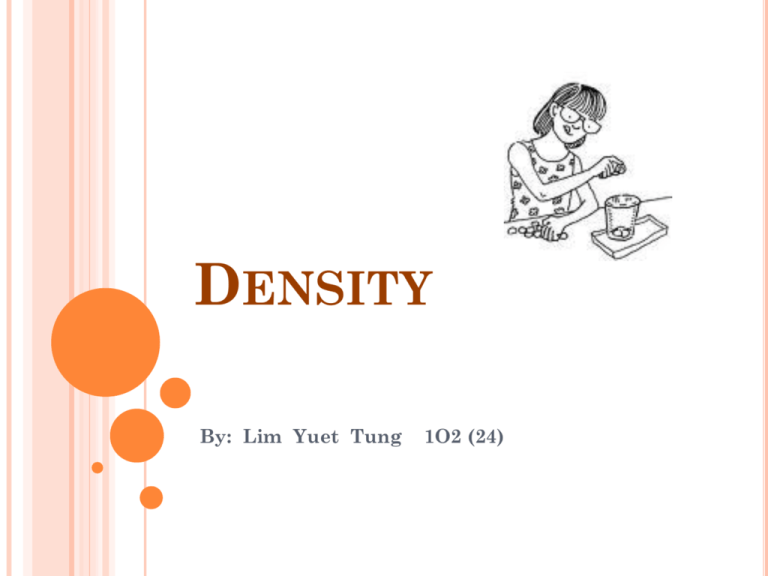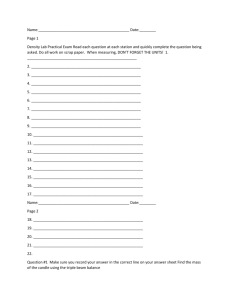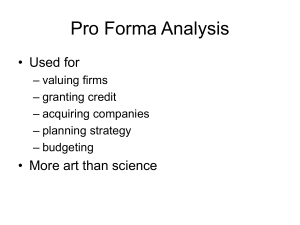Density - 1O224limyuettung
advertisement

DENSITY By: Lim Yuet Tung 1O2 (24) WHAT IS DENSITY? A material's density is defined as its mass per unit volume. A measurement of how tightly matter is crammed together. The principle of density was discovered by the Greek scientist Archimedes. Density is also called as (rho). HOW DOES DENSITY DISCOVERED? In a well-known tale, Archimedes was given the task of determining whether King Hiero's goldsmith was embezzling gold during the manufacture of a wreath dedicated to the gods and replacing it with another, cheaper alloy. HOW DOES DENSITY DISCOVERED? One day, Archimedes took a relaxing immersion bath and observed from the rise of the warm water upon entering that he could calculate the volume of the gold crown through the displacement of the water. Thus, after Archimedes found out that the king has been cheated, then the density was known by public. USES OF DENSITY Hot air balloons Hot air is less dense than colder air, hence the balloon will float up. USES OF DENSITY Cooking We depend on the fact that steam or warmer air is not very dense and thus takes heat away from the food USES OF DENSITY Boats Boats depend on density to stay aloft FORMULAE OF MASS, VOLUME AND DENSITY CHANGE OF DENSITY Density can be change by temperature and pressure. The increase of temperature will decrease the density. The increase of pressure will increase the density. CALCULATE DENSITY From the picture, we can easily know that substance “A” has the lowest density while the liquid “F” has the highest density as the object with more density will sink while the object with less density will float. CALCULATE DENSITY The following steps show how to calculate density of a regular object. I. II. III. IV. Find the mass of the object. Calculate the volume of the object. Use the mass of the object and divide it by the volume of the object. Repeat the experiment about 3 to 5 time and find the average of the density to make the answer more accurate. CALCULATE DENSITY The following steps show how to calculate density of an irregular object. I. II. III. IV. V. VI. Weigh the object to determine its mass Pour water into a measuring cylinder and read its volume and write it down as V1. Tie the object with a piece of string and lower it into the water. Note the volume reading as V2. The volume of the object is equal to (V2 – V1) Use the mass of the object and divide it by the volume of the object. Repeat the experiment about 3 to 5 time and find the average of the density to make the answer more accurate. HOW TO CALCULATE THE DENSITY OF AN ALLOY? Alloy is an object which mix by two or more elements. I. II. III. Calculate the total amount of mass of the two element. Calculate the total amount of volume of the two element. Divide its total mass by total volume and get the density of the alloy. WHAT MUST WE DO TO AVOID ERROR WHEN CALCULATE DENSITY? Make sure that the measurement that you are using starts on “0” to avoid any zero errors. Avoid parallax errors when reading the volume of an object inside a measuring cylinder. Repeat the experiment about 3 to 5 time and find the average to make the answer more accurate. DENSITY DEMONSTRATION: COKE VS. DIET COKE Materials: 12 ounce coke can 12 ounce diet coke can water fish tank sugar nutria sweet DENSITY DEMONSTRATION: COKE VS. DIET COKE Place the regular coke and the diet coke into the water. You will find that the diet coke will float on the water but the regular coke will sink into thee water. DENSITY DEMONSTRATION: COKE VS. DIET COKE The Density of water is 1g/cm3. An object will float is the density is less than 1. An object will sink if its density is greater than 1. We know that regular coke will sink but diet coke will float as nutria sweet is lighter than sugar . Also try this on different brands of sodas for example Pepsi, Dr. Pepper, Sprite, etc. DENSITY FOR SOME COMMON MATERIALS water Glass Granite Bone Human body Butter Ice Carbon Kerosene Chalk Salt Coal Sand Cork Sulfuric Acid Gasoline 1.00 2.60 2.65 1.85 0.995 0.94 0.917 2.60 0.80 2.36 2.20 1.50 2.80 0.25 1.84 0.72 DENSITY FOR SOME COMMON METALS Aluminum Brass Chromium Copper Gold Iron Lead Magnesium Mercury Nickel Platinum 21.50 Silver Tin Uranium Zinc 2.70 8.40 7.10 8.63 19.30 7.80 11.30 1.74 13.60 8.80 10.40 7.30 18.70 6.90 BIBLIOGRAPHY www.about.com http://www.elmhurst.edu/~chm/vchembook/121A densitycoke.html





